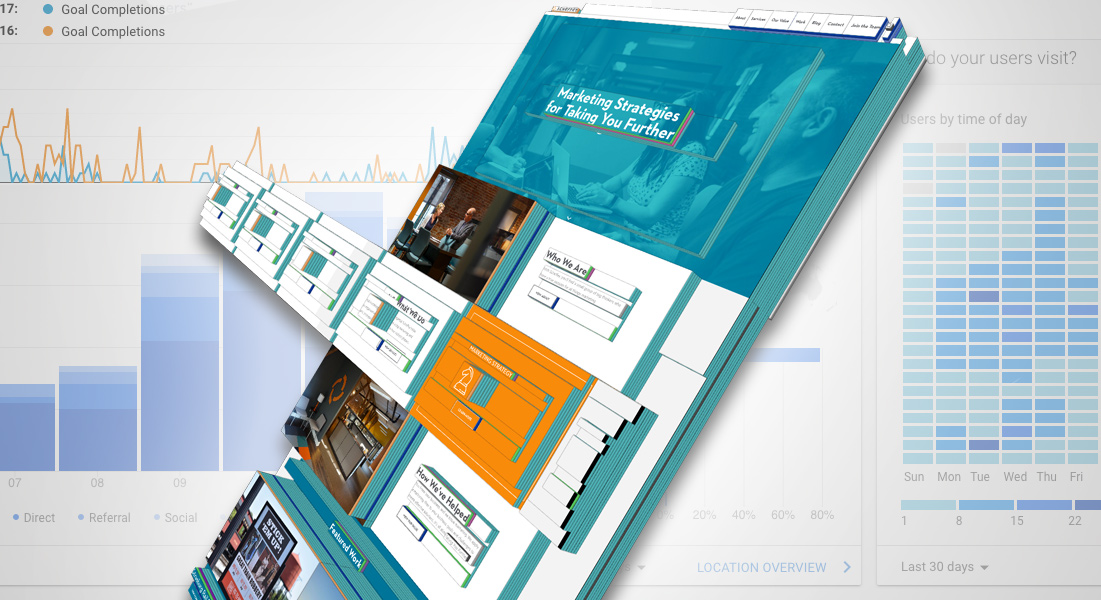Never Stop Building Your Website

We are experiencing a data obesity crisis. There is currently more data, more bandwidth to deliver data, and more power to process these mountains of data than any other point in human history. The true power of information lies not in the ability to collect the numbers, but in our ability to distill those numbers down to meaningful insights. As if all this is not enough, your website is not the only resource generating data anymore. Email platforms, social media networks, and other advertising platforms all augment website analytics with data and reporting of their own.
Making Sense Of Your Data
One of the single greatest paradigm shifts invented by the Internet is that nothing must remain fixed. Old media was immutable. Painstaking work went into producing and distributing perfect pieces that could never be changed once publicized. This is not true of the new digital landscape. Some corners of the Internet may have a long memory, but the vast majority has a malleable present state.
When we marry the overwhelming amount of data at our fingertips with the ability to rapidly change, and even experiment, we can move quickly and make strategic advances in marketing. In the recent past, tech giants like Facebook encouraged developers to “move fast and break things.” While we try to avoid breaking things, we believe the spirit of innovating and iterating quickly is essential to remaining competitive in today’s world.
(See some of our website projects.)
Data-Analysis Process
All this data sometimes tells what appear to be wildly conflicting stories. The real science in data science is correctly aggregating and correlating relevant data points while discarding the noise. In order to perform meaningful introspection, it is absolutely essential to define a sound process.
Define Realistic Objectives
This process often begins before any tangible work is performed on a project. When strong business objectives are defined at the outset of a project, every detail of the user experience can be tailored to meet these goals. A website is influenced by more than its own mere web presence. Other digital strategies like social networking and digital advertising drive traffic to the site as well. All of these sources need to be considered and strategized.
Some objectives simply cannot be defined by data alone. Realism is essential to this phase of the process. Outside factors like the general state of the economy or the normal ebb and flow of cultural interests can create difficult challenges. Digital objectives should focus heavily on measurable factors instead.
Set Distinctly Measurable Goals That Align With Objectives
Many types of data need to be categorized and filtered before collection begins or they will be hard, sometimes even impossible, to evaluate later. Setting measurable goals in your website analytics can help you make intelligent, data-driven decisions that drive continuous digital improvement strategies.
Evaluate
The time between evaluation periods will depend heavily on the individual project and the desired outcome. Some data should be reviewed daily, while other datasets need only weekly, monthly, or even quarterly review. If an element performs particularly well, it may need even less frequent oversight. These regularly scheduled touch points serve as the basis for fine-tuning the details that make up the goal.
Adjust, Rinse, and Repeat
This entire process is an iterative one. In the software industry we say, “build one to throw away.” Many of you probably built your first website many years ago. And you have probably “thrown away” several website variations since then. The good news is that modern tooling has equipped us to better update and work through many of these adjustments. Most websites are built on top of a content management system that makes tweaking content, media, and even layout simpler and faster than ever.
Experiment
Despite our best efforts, clear paths forward do not always emerge from data and goals. Sometimes it is impossible to make a determination without testing a theory first. Marketing strategies like A/B testing allow us to split options and collect unbiased data about each path. The path that performs best can then be implemented and tested in the ongoing cycle of regular evaluation.
Make mistakes quickly and learn from them equally as fast. This form of rapid prototyping allows you to shift your focus from the things you already do well on the Internet to those of which you are less certain. Each iteration should answer questions you have about some aspect of the objective. Respect the answers you receive from your experiments. Some things will work and many will not.
Much like your previous website, do not be afraid to throw away a failed experiment. There is no value in infinitely refining a broken idea.
“The road to success is always under construction.”
– Lily Tomlin
At Scheffey, our mission is to think, create, sell, and analyze. Building great digital products and analyzing their effectiveness are just a few of our specialties. Give us a call or get to know us a little better, and let’s take a look at what you can do with your next digital marketing campaign.
